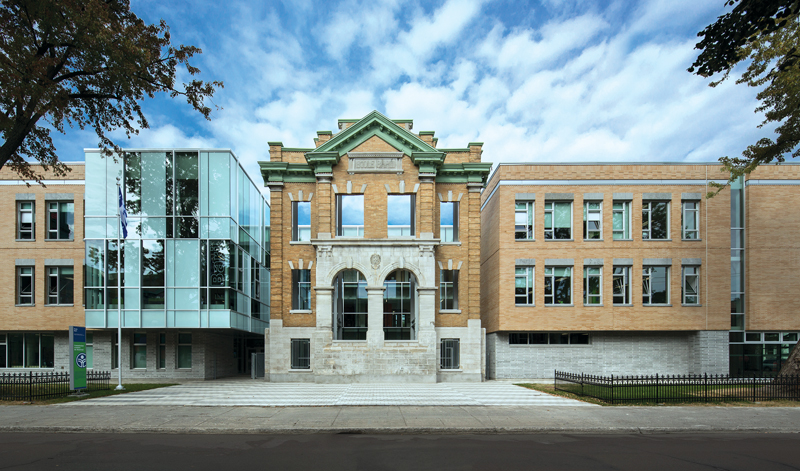State of the Nation: Quebec
“It’s busier than I’ve ever seen it,” says Gavin Affleck of Montreal’s Affleck de la Riva architects, who has practiced for 30 years. “Students and graduates are basically hired instantly,” says Anne Cormier, of Atelier Big City. Every firm in Quebec seems to agree: work is plentiful. Architects are comparing the current boom to the build-up of Montreal in the pivotal decade of the 1960s.

This winter, Montreal’s real estate sector overtook Vancouver as the second largest market in the country after Toronto. In the past year, housing has shown strong price growth, a period when prices in other cities softened. And the city still has “a lot of catching up to do,” says Gavin Affleck: there are many empty downtown lots that remain from the 1980s and 90s, when recessions and the threat of separation from Canada put the province in an economic rut.
The boom is also affecting heritage buildings, which are being restored and converted to new uses. The biggest of these is the multi-building Royal Victoria Hospital site, which flanks the southern edge of Mount Royal. The site sat in limbo for several years, but McGill University is now planning to convert the former hospital’s main building, a heritage structure dating back to 1893, into campus teaching and research spaces. In Old Montreal, the million-square-foot Gare Viger, Montreal’s original train station, is being converted into a mixed-use development by Provencher_Roy.

Good times come with challenges, and the biggest is a shortage of skilled intermediate and senior-level staff. It’s a generational challenge faced by firms across Canada, but on that is perhaps particularly acute in la belle province because of the language barrier—architects need to pass a French competency test to transfer their credentials to Quebec, slowing movement from other provinces.
The cities may also be underprepared for the current sudden growth. Maxime-Alexis Frappier of ACDF, who also works in Vancouver, says that Montreal lacks the tall-building regulations of the West Coast. “We are going to face challenges about the residential densification downtown,” he says. “Vancouver has strong criteria to protect the public realm; in Montreal, they have allowed us to go higher to have a greater density, but the projects still have large floorplates and a high podium.” Nonetheless, some private sector actors have taken the lead in delivering quality architecture. “Developers are understanding that good design can sell well,” he says.

On the public side, Quebec’s competition system has long been the envy of architects in the rest of Canada: a way to ensure quality architecture, and for young firms to land major projects based solely on their design chops. All provincially subsidized cultural spaces with a construction budget above $5-million must be procured through competitions, and municipalities can opt to use the competition system for other buildings, a choice frequently made by the City of Montreal. And indeed, many of Quebec’s best-known firms—including Montreal’s Atelier TAG and Atelier Big City—came to prominence through design competitions for theatres, libraries, and other publicly funded facilities.
In recent years, the system has been subtly changing. Adversity to risk, and particularly the threat of cost overruns, have led municipalities to tighten competition requirements. Many competitions now come with detailed technical and functional programs at the outset, tight budgets, and requirements for the applicant to have at least a decade of experience in practice as well as a certain number of completed projects of the same type. As a result, fewer firms are able to compete—and those that do succeed tend to get pigeon-holed in sectors based on their previous experience.
Still, says Gavin Affleck of Affleck de la Riva, the process is ultimately continuing to succeed in delivering quality work. “If you get shortlisted, you’ve really worked hard on your conceptual approach,” he says—a phase that often gets short shrift with the compressed timelines of private sector projects. Several upcoming projects awarded through competitions have won Canadian Architect Awards for design-stage work: these include Pelletier de Fontenay, Kuehn Malvazzi, and Jodoin Lamarre Pratte’s Insectarium in Montreal, KANVA’s renovation of the nearby Biodome, Atelier TAG and Architecture49’s installation of an observation belvedere in the lantern of Mount Royal’s Oratoire Saint-Joseph, and Saucier + Perrotte and GLCRM’s Gabrielle-Roy Library addition in Quebec City.

Perhaps equally important, the competition system has helped sustain a small-firm culture in Quebec. While many engineering firms merged in the 1990s, the typical Quebec firm is still a small to mid-sized enterprise—“an artisanal production,” as Affleck puts it.
This has been healthy for an architecture community that is active, in many ways, in creating its own fortune. Lobbying efforts, led by OAQ president Nathalie Dion, are advancing a provincial architecture strategy, which would further solidify architecture’s importance to Quebec culture. Architect Pierre Thibault was one of the champions of the grassroots Lab-École campaign to improve the design, food, and opportunities for physical activity in Quebec’s public schools. As part of the program, competitions are starting soon for renovations of several schools—and the rules have been opened up so that younger architects will have an opportunity to get in the game.
This article is part of our State of the Nation series covering Canadian architecture region by region.
